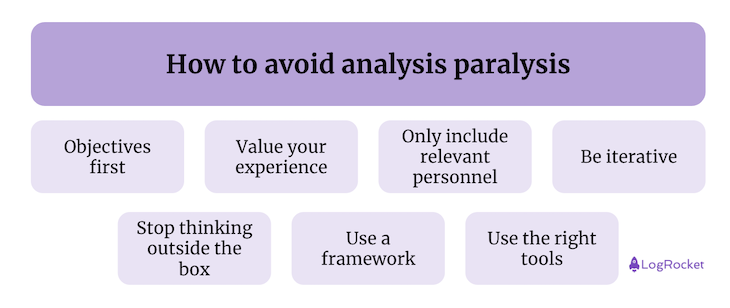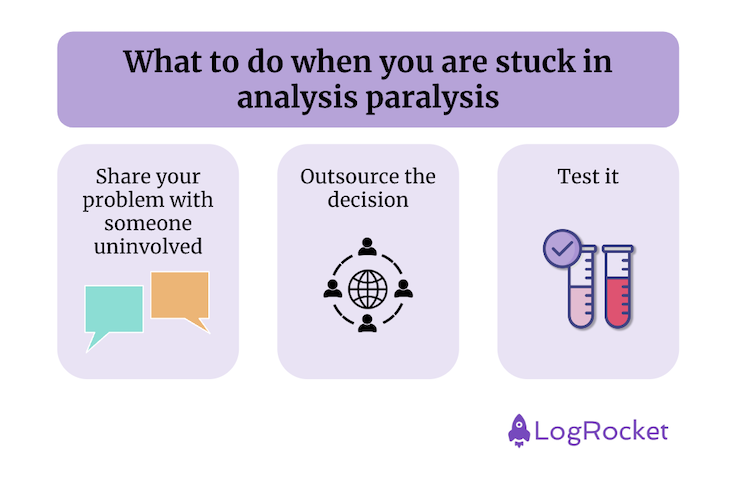Experienced product managers know to plan and think ahead before jumping into action. Younger, more impetuous professionals often commit to projects rather than products, and thus fail to deliver value to the user. The unadvised might think that product management is about planning instead of acting, but striking a balance between both stances is what separates an average from a good product manager.

There’s a lot written about the act-first mindset and how important it is to conduct discovery before compromising on delivery, but less is written on being bogged down by data and options. This phenomenon is known as analysis paralysis.
Analysis paralysis is more common than you might think. Ever found yourself caught in a cycle of overthinking, weighing one piece of data against another, and second-guessing your choices? That’s analysis paralysis.
Within a data-driven, decision-making culture, there’s a wealth of data at your disposal, but not all data is equal. The more “noise” you have, the harder it can be to separate relevant from irrelevant information.
In this article, you’ll learn what analysis paralysis is and how to avoid it, as well as strategies to overcome it. This will help you make more confident and effective decisions.
Analysis paralysis occurs when the decision-making process gets bogged down by the inability to make a decision, resulting in prolonged deliberations and, ultimately, inaction. It’s a self-feeding mechanism in which the more you question your reasoning, the further you get from a conclusion.
The causes of analysis paralysis vary but often revolve around the fear of making a wrong decision. This could be due to an overload of information, a desire for perfection, or a fear of the possible risks and adverse consequences. The more complex the decision or the more variables involved, the more likely it is that one could experience analysis paralysis.
The symptoms are usually quite apparent. You might find yourself or your team constantly gathering more and more data, yet never feeling confident enough to make a decision. Meetings become longer and more frequent with no concrete outcomes. Even when a decision seems imminent, there’s an insistent pull to revisit previous data or explore new alternatives, “just in case”.
Product managers are at the center of several question-answering processes: from sprint feature prioritization to vision building and strategy planning, the main value a product manager can deliver is effective and efficient decision-making. A product manager impacted by analysis paralysis is essentially a PM that can’t perform their craft.
Gathering and interpreting data can be done by anyone — that’s not why you are part of the team. The product manager position exists to make decisions, communicate those decisions, and iterate on those, if necessary, based on feedback. The original lean cycle is not about learning indefinitely, it’s about learning through practice, and ultimately achieving scale.
Disrupted decision-making in product management leads to suboptimal outcomes, including delayed launches, missed market opportunities, and even negative financial impacts. All this can be avoided though.
Consider a typical scenario. Your team has collected extensive user feedback on a potential new feature. The data is diverse, filled with contrasting views and suggestions. Meetings drag on as the team dives deeper into the data, but no clear decision emerges.
Meanwhile, competitors launch similar features, and your product’s edge begins to fade. This is a classic case of analysis paralysis. While it seems that the amount of information is to blame, the root cause here is the inability of the team to commit and take responsible risks.
The question then becomes, “How can we prevent analysis paralysis from slowing us down?” Here are some proactive strategies to keep decision-making flowing smoothly in product management:

Before diving into the data, know exactly what you are looking for. A well-thought objective will help you understand the data well. Focus on what’s most important at the expense of irrelevant data and your decisions are guaranteed to be more efficient. It’s naïve to think that data alone will answer your questions, so OKRs, KPIs, and targets are also your allies.
The less experience you have on the job, the less you should rely on this recommendation, but striving for the right balance between data and intuition can help you overcome analysis paralysis.
While data is undoubtedly at the core of your decision support, it shouldn’t completely override intuition. Your experience and gut feelings are also valuable, especially when data is conflicting or incomplete. When asked why you’re making decisions A or B, don’t shy away from referencing previous successful experiences that relate to the subject.
In design thinking, we broaden the horizon of possibilities when exploring solutions before narrowing those down to make a decision. Do the same with people participating in the discovery process. The more people involved in a decision, the more opinions and perspectives to consider, leading to longer deliberations and potential decision stalemate.
Always make sure to take into consideration as many stakeholders as possible, but limit the decision only to those that can perform the change and deal with its consequences.
Perfection can be a significant driver of analysis paralysis. Within software development, the old PMBOK is almost extinct, mainly due to this pursuit of a perfect, flawless project.
Embracing the concept of “good enough” is a cornerstone of iterative thinking and it’s fundamental to guarantee a nimble and efficient decision-making culture. Instead of chasing the elusive “perfect decision,” aim for a “good enough” one that meets your objectives and can be implemented quickly.
Self-imposing some limitations that are healthy for the business or for the user encourages efficiency, helps focus discussions, and prevents unnecessary deliberation. An emblematic episode that supports this claim is how NASA managed to save the lives of three astronauts during the Apollo 13 mission. The harsh limitations they faced, both on time and resources, were instrumental for the team back on earth to come up with an effective and successful solution.
Sometimes, despite your best efforts, you get overwhelmed with information, and that’s ok. That’s when using a decision-making framework can be beneficial. Frameworks provide a structure to your information, which can help you navigate through the chaos of some datasets.
Frameworks like RICE (reach, impact, confidence, and effort) or CSD (certainties, suppositions, and doubts) can aid in evaluating options and making informed decisions.
A lot of analysis paralysis can be considered a personal development opportunity, but the quality and amount of data you have at your disposal are not entirely excusable. Having the right tools tracking the right data goes a long way toward helping you to beat analysis paralysis. Luckily enough, the company hosting this very blog post is a prime example of how a feature can help you to beat analysis paralysis.
It happens to the best of us. Sometimes analysis paralysis takes hold of our decision process no matter how much we try to avoid it. It might be conflicting data, murky context, lack of experience, or a tight deadline. Whatever the reason, it’s important to know how to break away from the fear of taking action.
Here are some strategies you can use to get out of a paralysis situation:

Whether by hearing yourself out loud or by receiving fresh insights, sharing is a great way to fight analysis paralysis.
It can be a colleague, a friend, your partner, your boss, whomever. The important thing is that this person is not part of your dilemma. People involved with the subject that needs addressing might be biased — short-sighted by their own involvement or even victims of analysis paralysis themselves.
Getting the wrong input might keep you stuck or, even worse, lead you to a wrong conclusion.
Sometimes, we bite off more than we can chew. And that’s OK. We are not meant to work alone, that’s why we have a whole structure around us: managers, C-level executives, specialists, and other teams.
Analysis paralysis might be born from a lack of experience or understanding of a given subject. If someone asked me to pick a truck model for assembling a fleet, I wouldn’t know which to choose. I know nothing about trucks, so it would probably be best to let a specialist decide.
The Lean cycle is based on a single premise: it’s impossible to predict what users want and you must learn by trying it out. The whole “iteration” and “MVP” literature exists specifically to tackle analysis paralysis when it comes to big decisions. Whenever a product is starting, data will be limited and you’ll have way more questions than answers.
Going in blind might be just what you need to make a decision further down the line with conviction. Making a “wrong” decision and learning from it is actually a win.
A collection of wrong decisions can produce enough knowledge to make the right decision.
Analysis paralysis might sound like just another jargon with no real impact on product performance, but this idea couldn’t be further from the truth. The seemingly silly act of overthinking can balloon into substantial delays, missed opportunities, and suboptimal product outcomes. As we’ve discussed, understanding analysis paralysis — its causes, symptoms, and impacts — is the first step toward addressing it.
Overcoming analysis paralysis requires a combination of clear objectives, risk appetite, professional experience, consensus avoiding, iterative mindsets, and employing smart decision frameworks.
The goal is not to act without thinking but to think more efficiently and confidently.
Featured image source: IconScout

LogRocket identifies friction points in the user experience so you can make informed decisions about product and design changes that must happen to hit your goals.
With LogRocket, you can understand the scope of the issues affecting your product and prioritize the changes that need to be made. LogRocket simplifies workflows by allowing Engineering, Product, UX, and Design teams to work from the same data as you, eliminating any confusion about what needs to be done.
Get your teams on the same page — try LogRocket today.

A practical guide for PMs who want to stop being bottlenecks, delegate smarter, and lead teams effectively with a clear ownership framework.

Stop letting unreliable data block features. Treat data as inventory to track quality, ownership, and ship with confidence.

Learn why slide decks slow teams down and explore better tools like whiteboards, PRDs, and prototypes to improve collaboration and alignment.

AI PM roles are evolving fast. Learn the five types of AI PMs, the skills they need, and how they shape AI products across industries.